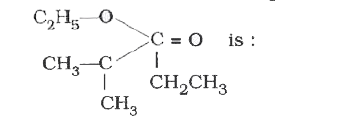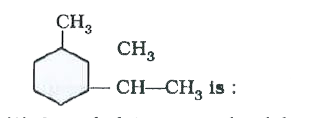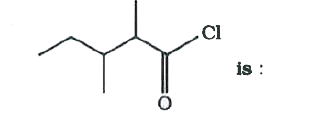Complete Solutions to Multiple Choice Questions Level - I of chapter ORGANIC CHEMISTRY : SOME BASIC PRINCIPLES of Class 12 book with complete answers and questions
| Class 12 | CHEMISTRY |
| Chapter | ORGANIC CHEMISTRY : SOME BASIC PRINCIPLES |
| MODERN PUBLICATION | Multiple Choice Questions Level - I |
| Number Of Questions | 83 |
| Academic Year | 2023-24 |
The maximum catenation tendency of carbon is due to :
04:09View SolutionWhich of the following statements not correct regarding sp hybridisation of carbon ?
04:42View SolutionWhich of the following stetments is not correct regarding the geometry of acetylene ?
03:33View SolutionThe bond between carbon atoms 1 and 2 in the compound :
`N-=overset(1)(C)-overset(2)(C)H=CH_(2)` involves the hybridised carbon as :03:58View SolutionWhich of the following has shortest `C-C` bond length ?
04:13View SolutionThe hybridisation of carbon atoms in `C-C` single bond of `HC-=C-CH=CH_(2)` is :
04:05View SolutionWhich of the following hybrid orbitals has highest s - character ?
05:31View SolutionWhich of the following is not a cyclic compound ?
05:25View SolutionThe suffix for alcohols, aldehydes and ketones, according to IUPAC system are respectively :
03:51View SolutionAccording to the IUPAC system `CH_(3)CH_(2)COCl` is named as :
01:44View SolutionThe IUPAC name for the compound :
`CH_(3)-underset(C_(2)H_(5))underset(|" ")(CH)-CH_(2)-underset(OH" ")underset(|" ")(CH)-CH_(3)` is03:04View SolutionThe IUPAC name for the compound :
`CH_(3)-underset(O)underset(||)(C)-CH_(2)-CH_(2)OH` is03:26View SolutionThe correct IUPAC name for the compound `(CH_(3))_(3)COH` is :
02:19View SolutionWhat is the IUPAC name of the compound :
`underset(OH)underset(|)(CH_(2))-underset(NH_(2))underset(|)(CH)-COOH`04:28View SolutionWhich of the following compounds contain amide functional group ?
03:36View SolutionWhich of the following formulae represents 2, 5-Dibromo-4-ethyl-2-heptenal according to IUPAC rules ?
03:54View SolutionThe IUPAC name for the compound
`CH_(3)CH=underset(" "C-=CH)underset(|" ")(CHCHCH_(3))` is :03:32View SolutionThe IUPAC name of the compound :
 01:54View Solution
01:54View SolutionThe IUPAC name of the compound :
 01:52View Solution
01:52View SolutionThe structure of neopentane is :
01:41View SolutionThe IUPAC name of the compound :
 02:45View Solution
02:45View SolutionThe structure of methyl phenyl ether is :
02:40View SolutionThe first organic compound synthesised in the laboratory was :
02:20View SolutionWhich of the following molecules involves `sp^(2)` hybridisation of the carbon atoms ?
02:42View SolutionThe number of `pi-` bonds in naphthalene is :
01:45View SolutionThe IUPAC name of ether :
`CH_(3)-O-C_(2)H_(5)` is :01:57View SolutionThe correct IUPAC name of the compound :
`H-overset(O)overset(||)(C)-overset(O)overset(||)(C)-H` is :01:45View SolutionThe IUPAC name of the compound `(C_(2)H_(5))_(4)C` is :
02:42View SolutionThe IIUPAC name of `C_(17)H_(35)COOH` is :
02:08View SolutionWhat is the IUPAC name of the compound :
`underset(OH)underset(|)(CH_(2))-underset(NH_(2))underset(|)(CH)-COOH`04:28View Solution`C_(n)H_(2n)` is the general formula of :
02:17View SolutionThe IUPAC name of the following compound is :
 02:40View Solution
02:40View SolutionThe common name of the compound :
`CH_(3)CH_(2)C(CH_(3))_(3)` is :02:03View SolutionHow many primary carbon atoms are present in a 2,2,4-trimethyl pentane ?
03:29View SolutionThe compounds having a common difference of `CH_(2)` in their molecular formulae are known as :
02:22View SolutionWhat is the correct IUPAC name of the following compound ?
`CH_(3)(CH_(2))_(4)underset(CH_(3))underset(|)(CH)-underset((CH_(2))_(2)CH_(3))underset(|)overset(CH_(3))overset(|)(C)-CH_(2)CH_(3)`04:37View SolutionThe IUPAC name of the compound :
`CH_(3)CONH(Br)` is :02:38View SolutionThe total number of tertiary carbon atoms in 4, 5-dimethyl-2-hexanol is :
02:23View SolutionThe correct IUPAC name of acetonitrile is :
01:49View SolutionThe IUPAC name of the compound
 is :03:34View Solution
is :03:34View SolutionThe IUPAC name of the compound
 is :01:46View Solution
is :01:46View SolutionThe IUPAC name of the compound
`underset(CN" ")underset(|" ")(CH_(2))-underset(CN" ")underset(|" ")(CH)-underset(CN" ")underset(|" ")(CH_(2))` is03:13View SolutionThe systematic name of : `CH_(3)-CHBr-CH_(2)OH` is
03:10View SolutionThe IUPAC name of `(C_(2)H_(5))_(2)CHCH_(2)OH` is :
03:12View SolutionThe IUPAC name of `CH_(3)COOC_(2)H_(5)` will be :
03:29View SolutionWhich one of the following IUPAC names is correct ?
05:05View SolutionNeo - heptyl alcohol has the formula :
03:11View SolutionThe IUPAC name of the compound :
`CH_(3)-underset(CH_(2)-CH_(3))underset(|" ")(CH" ")-CHO` is :02:52View SolutionThe IUPAC name of the compound
 is :03:57View Solution
is :03:57View SolutionThe IUPAC name of the compound :
 is : 03:06View Solution
is : 03:06View SolutionThe IUPAC name of the compound :
`CH_(3)-CH_(2)-underset(OCH_(3))underset(|)(C)=O` is :02:34View SolutionThe IUPAC name of the compound :
`(CH_(3))_(2)CHCH_(2)CH_(2)Br` is :03:22View SolutionThe IUPAC name of the compound :
`(CH_(3))_(3)C-CH=CH_(2)` is02:14View SolutionThe number of `pi` bonds in
`CH_(2)=CH-CH=CH-C-=CH` is01:33View SolutionThe structure of 4-methyl-2-pentan-1-ol is :
03:28View SolutionThe IUPAC name of
 03:11View Solution
03:11View SolutionWhich of the following species has electron releasing (or+I inductive) effect ?
03:57View SolutionThe displacement of electrons in a multiple bond in the presence of attacking reagent is called
01:58View SolutionWhich of the following pairs represents only electrophiles ?
03:40View SolutionWhich of the following carbocations will be the most stable ?
04:50View SolutionWhich of the following carbocations will be the most stable ?
02:03View SolutionIn terms of relative stability, which of the following is in general, wrong :
07:12View SolutionWhich of the following is not the correct condition for resonance ?
07:56View SolutionWhich of the following carbonium ions has the least stability ?
05:23View SolutionThe shape of carbomium ion is :
04:16View SolutionWhat is the hybridization of central C-atom in trimethyl carbonium ion ?
03:58View SolutionWhich of the following is not a nucleophile ?
03:39View SolutionA nucleophile is a :
03:45View SolutionWhich of the following shows electromeric effect ?
04:42View SolutionWhich of the following undergoes electrophilic substitution reaction ?
04:26View SolutionWhich of the following is not a nucleophile ?
03:39View SolutionThe heterolytic cleavage of a carbon-chlorine bond produces :
04:43View SolutionAn electrophilic reagent is :
02:54View SolutionThe negative inductive effect is shown by :
03:00View SolutionWhich of the following substituents has `+M` effect ?
04:57View SolutionThe most stable free radical is :
06:22View SolutionWhich of the following is an allyl group ?
02:50View SolutionWhich of the following is neither a nucleophile nor an electrophile ?
02:42View SolutionPolarisation of electrons in acrolein may be written as :
03:53View SolutionThe least stable carbonium ion is
04:42View SolutionHypercojugation effect is also known as
02:31View SolutionElectrophilic addition reactions proceed in two steps. The first step involves the addition of an electrophile. Name the type of intermediate reaction.
`H_(3)C-HC=CH_(2)+H^(+)to?`02:23View SolutionCovalent bond can undergo fission in two different ways. The correct representation involving a heterolytic fission of `CH_(3)-Br` is
03:54View Solution
Multiple Choice Questions Level - I questions and complete solutions for chapter ORGANIC CHEMISTRY : SOME BASIC PRINCIPLES of MODERN PUBLICATION CHEMISTRY (KANNADA ENGLISH) of Class 12
